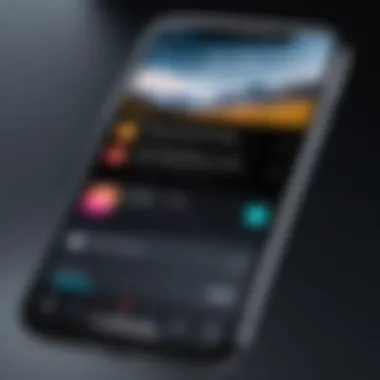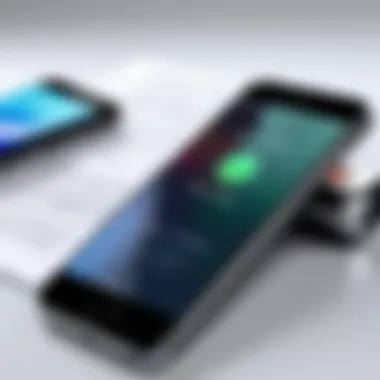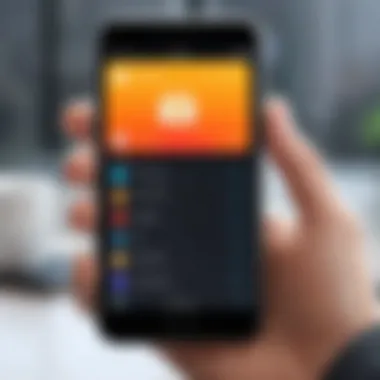Recording Phone Calls on an iPhone: A Comprehensive Guide


Intro
Recording phone calls on an iPhone involves navigating through both the technology available and the legal implications associated with such actions. The iPhone, known for its sophisticated design and powerful operating system, offers several methods to record calls, either through built-in features or third-party applications. However, users must be aware of laws regarding consent and privacy before engaging in call recording.
This guide will provide detailed insights into the best practices, technical options, and legal considerations relevant to recording phone calls on an iPhone. Readers will gain an understanding that goes beyond mere steps—this guide aims to equip the tech-savvy audience with essential knowledge about the tools at their disposal. From the implications of unauthorized recordings to optimizing use of applications designed for this purpose, it is crucial to understand all facets involved in this process.
Prelude to Call Recording
Recording phone calls on an iPhone has become increasingly relevant in both personal and professional contexts. As our reliance on mobile communication grows, the need for accurate and secure call documentation has emerged. This section will delve into the significance of recording calls and the varied situations in which it can be beneficial.
Importance of Call Recording
The ability to record phone calls can serve multiple purposes. For businesses, it can enhance training and quality assurance practices. Training new employees using real call scenarios ensures that they learn effectively from best practices or mistakes. For individuals, retaining a record of critical conversations might be essential for verifying discussed points, agreements, or even personal matters. The clarity of details provided in a recorded call can eliminate misunderstandings that often arise from human memory.
From a legal standpoint, call recording can provide valuable evidence in disputes. In situations such as negotiations or agreements, having a verified account of what was said can prevent conflicting interpretations later on. Moreover, in a world where online transactions and digital interactions are commonplace, keeping records can help individuals feel safer and more prepared when engaging in significant discussions.
Overall, the importance of call recording hinges not only on personal convenience but also on ensuring accuracy and accountability in conversations. The capacity to revisit conversations contributes to a more organized approach in professional settings as well as personal matters.
Use Cases for Recording Calls
The scenarios where call recording can be advantageous are numerous. Some prominent use cases include:
- Business Training: New employees can listen to recorded calls to understand customer interactions better.
- Customer Support: Evaluating the quality of support provided by an agent can be optimized through recorded interactions.
- Legal Documentation: In cases where legal agreements are made, having a recording can serve as proof.
- Interviews: Recording interviews can help with analysis and transparency during hiring processes.
- Personal Conversations: From clarifying personal commitments to preserving cherished memories, recording calls can be useful in many aspects of life.
Legal Considerations
Understanding the legal landscape surrounding call recording is crucial for any iPhone user considering this capability. The laws vary significantly based on jurisdiction, making awareness of both state and federal laws imperative. Clear comprehension of these regulations not only safeguards you from potential legal pitfalls but also helps maintain ethical standards during call recording.
Understanding State Laws
Every state in the U.S. has its own set of regulations regarding the recording of telephone conversations. Generally, these laws can be categorized into two major types: one-party consent and two-party consent.
- One-party consent states allow you to record a call if at least one party involved consents to the recording.
- Two-party consent states require that all parties involved in the conversation agree to the recording.
For instance, California and Florida adhere to the two-party consent rule, meaning that if you plan to record a conversation while in these states, you must obtain permission from every party involved.
It's critical to familiarize yourself with the laws that govern your specific state to avoid serious legal ramifications.
Federal Law Implications
At the federal level, the Wiretap Act primarily regulates the interception of wire, oral, and electronic communications. Under this act, similar to state laws, only a one-party consent approach is permissible. This means if you are a participant in the call, you can record it without informing the other party.
However, it is essential to recognize that federal law does not override state laws. Thus, if you find yourself in a situation adhering to a stricter state law, those regulations take precedence. Understanding both frameworks ensures compliance and might spare you from potential legal entanglements.


Consent Requirements
The requirement for consent plays a pivotal role in the recording of phone calls. As mentioned before, laws differ between jurisdictions, but generally, consent rules can be broken down into the following aspects:
- Timing of Consent: Consent can often be given verbally at the beginning of the call, although it is advisable to secure consent ahead of time for clarity.
- Documentation of Consent: Keeping a record of the consent can serve as a protective measure if disputes arise later. A simple note or even a text message can suffice.
- Understanding the Nature of Consent: Consent must be informed. This means that parties should know what they are agreeing to when they consent to the recording.
Being aware of these consent requirements not only ensures compliance but also promotes trust and transparency between parties involved in the conversation. Ignoring these vital aspects could lead to significant misunderstandings or legal challenges in the future.
Native iPhone Call Recording Options
Recording calls on an iPhone can be a challenging task due to the strict policies enforced by Apple regarding privacy and security. Native options for call recording offer certain advantages and limitations that users must be aware of before proceeding with their recording endeavors. Understanding these features is essential for ensuring that users can record important conversations while staying within legal boundaries.
Overview of Built-in Features
While iPhones do not have a built-in call recording feature directly accessible, there are workflows that enable users to accomplish this goal. For instance, using services like Google Voice allows you to record calls by simply pressing a number during the call. This feature is useful for those who want a straightforward approach to recording without relying on third-party applications.
The voice memos device is also beneficial for capturing quick conversations, but it is limited to calls that are placed on speakerphone. Users can initiate a voice memo recording prior to dialing and switch to speaker mode when the other party answers. This method, however, may reduce audio quality and discretion.
Limitations of Native Options
Despite these available options, the limitations can hinder the user experience.
- No Direct Integrated Solution: Users cannot record calls directly within the iPhone’s phone app, which adds complexity to the process.
- Audio Quality: When using speakerphone for recording, the clarity may suffer, making it difficult to hear the conversation accurately.
- Privacy Concerns: There is a higher risk of privacy violations, as other parties may not be aware that the call is being recorded, leading to potential legal issues.
- Restricted to Certain Services: Relying on services like Google Voice for call recording can limit users to specific types of calls, and restrictions can apply to international user interactions.
In sum, while there are options for native call recording on iPhones, they come with significant drawbacks. Users should evaluate these limitations against their recording needs to determine if additional resources are necessary.
Third-Party Call Recording Applications
Using a third-party application for call recording can be essential for users seeking more flexibility and enhanced features than those provided by iPhone's native options. These applications often come with numerous functionalities that cater to specific recording needs, be it for business purposes, interviews, or personal conversations. The importance of understanding these options cannot be understated, especially in an age where digital privacy and documentation have become increasingly relevant.
Popular Recording Apps
Several third-party applications are well-regarded in the realm of call recording on iPhones. Here are a few notable ones:
- Rev Call Recorder: This app offers free call recording without limitations. Users like its simplicity and the option to transcribe recordings for a fee.
- TapeACall: Known for its user-friendly interface, TapeACall allows users to record calls effortlessly. It offers both a free trial and a paid version.
- Call Recorder - ACR: ACR provides several features, such as cloud integration and the ability to sync recordings across multiple devices. Its subscription model unlocks advanced functionalities.
- Google Voice: While primarily a communication tool, Google Voice offers basic call recording features for incoming calls. Users must activate this function manually for recording.
Each of these applications has unique strengths, making them suitable for different circumstances. However, users should always check for compatibility with their iPhone model and iOS version.
Comparative Analysis of Features
When selecting a recording app, comparing features is crucial to determine what best fits individual needs. Here are some elements to consider while making comparisons:
- Audio Quality: The clarity of the recordings is paramount. Some apps compress audio files, which can affect quality.
- Ease of Use: User experience varies significantly among apps. A straightforward interface can enhance usability.
- Storage Options: Check to see whether the app allows local storage or cloud storage. Unlimited cloud storage can be a significant advantage.
- Transcription Services: Some apps provide automated transcription, which is helpful for users needing written documentation of their calls.
- Import/Export Options: The ability to share and export recordings easily is also a desirable feature.
Subscription vs. Free Models


App offerings generally fall into two categories: free and subscription-based models. Each has its advantages and disadvantages:
- Free Models: While appealing due to no financial commitment, free versions often come with limitations like fewer features, ads, or restricted recording time.
- Subscription Models: Paid versions typically offer a more comprehensive range of advanced features, higher audio quality, and a better overall user experience. Users may find the investment worthwhile for increased efficiency and reliability.
Here’s a side-by-side comparison:
| Feature | Free Apps | Subscription Apps | | Audio Quality | Moderate | High | | Recording Duration | Limited | Often Unlimited | | Transcription | Not Included | Usually Included | | Ads | Usually Present | Ad-Free Experience | | Customer Support | Limited | Priority Support |
Understanding the pros and cons of each model will help users make informed decisions regarding which app best serves their call recording needs, balancing cost with functionality.
Technical Steps for Recording Calls
Recording calls on an iPhone is a delicate process that involves several key steps to ensure it is done correctly. This section aims to demystify the technical procedure and provide you with a clear roadmap. With an understanding of these steps, you can enhance your call recording experience, whether for personal or professional use. Following a systematic approach not only improves the quality of the recordings but also assists in compliance with legal requirements.
Setting Up Your Recording Application
To begin recording calls, you first need to select and set up a reliable recording application. Various apps are available, each offering unique features and functionalities. Choose one that aligns with your specific needs.
- Download the App: Navigate to the App Store and find a reputable call recording app such as Rev Call Recorder or TapeACall. Evaluate user reviews to gauge effectiveness.
- Create an Account: Upon installing the app, you may be required to create an account. This step often enhances the app's functionality and allows for better management of recordings.
- Configure Settings: Adjust the settings in the app to suit your preferences. This may include options like audio format, file quality, and storage location.
- Test the App: Before making important calls, test the app with a friend or family member. This ensures that your settings are optimal and that you understand how to use the app effectively.
Executing a Call Recording
Once your recording application is set up, executing a call recording is the next critical step. The process generally involves the following:
- Initiate a Call: You can start the call using either the app or the native phone dialer. Ensure your call is connected.
- Add the Recording Line: Depending on the app, you might have to merge a recording line into the call. Follow the specific instructions provided by your chosen app for this step.
- Confirm Recording: Make sure you receive confirmation from the app that the recording is in progress. Double-check the audio levels and clarity to ensure that the recording will be of high quality.
- End Call: After going through your discussion, simply hang up to stop the recording. The app should automatically save the audio file.
Saving and Accessing Recordings
After a successful call recording, it is essential to know how to save and access those recordings. Each app may have different procedures, but some common practices include:
- Automatic Saving: Most recording applications will auto-save your recordings. However, check if your app allows you to specify a folder or location for easier access later.
- Organizing Files: Create folders within the app or your file system to categorize recordings by date, purpose, or contact. This makes retrieving specific recordings more manageable.
- Accessing Recordings: To listen to your recordings, navigate to the app’s library or folder. Select the desired file to play, edit, or share.
- Backing Up: Consider backing up important recordings to a cloud service or external storage. Applications often offer options to export files for safekeeping.
Always remember to respect privacy and legal regulations surrounding call recording, and notify all participants if need be.
Best Practices for Call Recording
When engaging in call recording, adhering to best practices enhances both the quality of the recordings and the ethical standards surrounding their use. These practices ensure clarity, compliance with laws, and proper management of recorded data. Implementing these guidelines minimizes risks and maximizes the value of the recordings for future reference.
Ensuring Audio Clarity
The clarity of the audio is foundational in call recording. Frequent issues include background noise and low volume. Clear recordings are essential not just for personal use but also when follow-up actions depend on accurate details. To achieve optimal sound quality, consider employing these strategies:
- Choose a Quiet Environment: Reduce background noise by recording in a quiet location. This can drastically improve audio clarity.
- Use Quality Devices: Invest in a high-quality external microphone. Devices like the Shure MV5 or Zoom n offer superior sound capture compared to built-in phone mics.
- Maintain Proximity: Keep the microphone close to the speaker. This can help in capturing clearer audio and minimizing interference.
- Check Settings: If using an app, ensure that recording settings are configured for high-quality audio.


In summary, focusing on audio clarity not only improves the quality of the recordings but also enhances the effectiveness of the content captured during calls.
Managing Storage Space
Managing storage is a critical aspect of call recording. As recordings accumulate, they can consume significant space on an iPhone. Users should be proactive in managing recordings to prevent device slowdowns or interruptions due to a lack of storage.
Tips for effective storage management include:
- Regularly Review Recordings: Frequently check your saved recordings and delete those that are no longer necessary. This keeps storage needs in check.
- Utilize Cloud Storage: Consider using services like Google Drive or Dropbox for backing up recordings. Storing files externally helps in maintaining device storage.
- Compress Files: Use applications that offer file compression. Smaller file sizes take up less space while maintaining acceptable quality.
- Set Retention Periods: Establish a routine for how long recordings should be kept. This leads to disciplined management of audio files.
By implementing these practices, users can avoid unexpected storage problems and ensure that their devices operate efficiently.
Privacy Concerns with Call Recording
Recording phone calls raises significant privacy concerns that warrant careful consideration. With the increasing prevalence of remote communication, understanding these implications becomes crucial for both users and the individuals involved in the conversation. Call recording is not just about functionality; it also involves navigating the fine line between convenience and respecting personal boundaries.
The primary benefit of recognizing privacy concerns lies in the ability to safeguard sensitive information. When recording calls, users must ensure they are protecting recorded data from unauthorized access. This includes employing robust security measures and being aware of potential vulnerabilities that could expose recordings to third parties. For example, if an app lacks solid encryption protocols, it may leave recordings susceptible to hacking.
In addition to data security, ethical considerations should not be overlooked. Call recording often involves personal conversations where both parties have a right to their privacy. Practicing transparency can foster trust and mitigate misunderstandings about intentions behind the recording. It's essential to communicate openly about the recording process, ensuring that all participants feel comfortable and consent to the recording.
Most importantly, recording a conversation without informed consent can lead to legal consequences and damage relationships. Upholding ethical standards in recording practice preserves dignity while safeguarding personal and professional interactions.
Understanding the dual aspects of privacy—data protection and ethical practices—enhances the approach to call recording. Users can strategically navigate these challenges, helping them leverage call recording features responsibly and effectively.
Protecting Recorded Data
Protecting recorded data is a fundamental aspect of call recording. Users need to employ strong security measures to prevent unauthorized access to sensitive information. These measures include the following:
- Use Encryption: Opt for applications that offer end-to-end encryption. This measure protects recordings from interception during transmission.
- Password Protection: Set strong, unique passwords for recording apps. This adds a layer of security, ensuring that even if a device is compromised, access to recordings remains restricted.
- Regular Updates: Keep both the operating system and apps updated. Software updates often fix security vulnerabilities that may be exploited by malicious actors.
- Secure Cloud Storage: If recordings are stored online, make sure to use reputable cloud services that offer high-level security features. Review their privacy policies to ensure data protection.
By actively implementing these strategies, users can significantly enhance the protection of recorded data, providing peace of mind.
Ethical Recording Practices
Ethical recording practices are vital in maintaining trust and integrity in communication. Here are key points to consider:
- Seek Consent: Always inform the other party about the recording. Obtaining consent not only aligns with legal requirements but also fosters transparency.
- Limit the Scope: Only record conversations that are necessary for documentation or clarity. Avoid recording personal or sensitive discussions unless absolutely needed.
- Respect Context: Be mindful of the context of the conversation. Some situations, such as confidential discussions in professional settings, warrant additional caution about recording.
- Handle with Care: Treat recordings as sensitive information. It’s important to manage and delete them responsibly if they are no longer needed, thus minimizing the risk of inadvertent data exposure.
Practicing these ethics will enhance your reputation as a responsible user of recording technology while ensuring that the rights and privacy of all parties involved are respected.
Ending
The conclusion encapsulates the essential aspects of recording phone calls on an iPhone. It serves as a summation of the insights shared throughout the article, bringing clarity and emphasis to the topic for the reader. Understanding the intricacies of call recording involves a combination of legal awareness, technical know-how, and ethical considerations. Recognizing these elements will empower users to make informed decisions while recording calls.
Summary of Key Points
- Legal Aspects: It is imperative for users to grasp the legal framework surrounding call recording. Not every state or country has the same regulations. It is essential to take the time to learn about local laws, ensuring compliance and avoiding potential issues.
- Technical Steps: Familiarity with the technical functionalities available on the iPhone is crucial. Knowing how to utilize both native features and third-party applications can enhance the user experience. Understanding the entire process— from setup to execution of recording—is necessary for successful outcomes.
- Privacy and Ethics: Users must address privacy concerns by safeguarding recorded data. It is also important to follow ethical practices by informing other parties involved that the conversation is being recorded.
Final Recommendations for Users
- Research and Choose Wisely: Users should thoroughly research various applications and methods of recording. Ideally, a balance of features and user-friendliness should dictate the choice of app. Evaluating user reviews and seeking recommendations can provide valuable insights.
- Stay Informed on Legal Changes: As laws regarding privacy and recording evolve, staying updated is necessary. Regularly consult reliable legal resources or news outlets to be aware of any changes potentially affecting your recording practices.
- Maintain Quality Control: Regularly check and manage storage space on the device to ensure recordings are preserved without compromising device performance. Deleting unnecessary files can enhance overall efficiency while maintaining important data.







